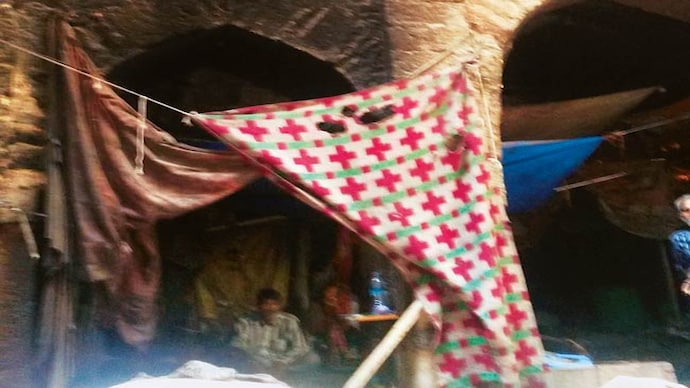Delhi's heritage sites grapple with neglect and encroachment
Several structures from the Lodi and Tughlaq periods lie in a shambles while some unidentified tombs have been turned into even shelters.

Historically, it is the tomb of Adam Khan, the son of a nurse who suckled Akbar. Khan was killed by the Mughal emperor for revolting against him. But for Mehrauli residents, it's merely a 'Bhool Bhulaiya' (labyrinth).
Rashid, a local, shares an anecdote: "My great-grandfather once told me that an entire wedding party got lost in the underground maze and hasn't been found. Since then, the government has sealed all the doors that run through the pillars."
To prove his claim, Rashid points at the signs of cemented/ padlocked doors on the tomb's walls. Interestingly, not one person on the premises knows the building's Adam Khan connection. So, whose tomb is it? Rashid answers sheepishly, "A great raja's!"
Rashid isn't the only one clueless about a monument bang in the middle of the city, nor is Bhool Bhulaiya the only historical building to succumb to this fate. A tour around the city reveals the miserable state of many others.
For instance, Chaumachi Khan's tomb is situated in Nai Basti, Mehrauli, but locating it is an onerous task. The residents don't even know that the 16-century state-protected structure exists in their midst.
Residential buildings encircle it tightly, making it impossible to spot it. A pile of rubble and some step ladders hint at some renovation work. A forlorn guard seated next to this activity is surprised by the interest: "This place used to be inaccessible. One had to climb the grills of a private property to see it. But renovation has started here since the past three months."

Encroachment
Manish, a 13-year-old whose house almost touches the rooftop of Chaumachi Khan's tomb, says: "It used to be just a dump. Some boys used my terrace to jump to the top of the tomb and do bad things there. No one could get them because the entrance was sealed and there are no stairs to the top."
Even with the Archaeological Survey of India (ASI) and the state protecting 174 and 33 monuments respectively, many of Delhi's heritage sites still grapple with encroachment or neglect. Several structures from the Lodi and Tughlaq periods lie in a shambles. Some unidentified tombs have been turned into even shelters.
"Buildings come up right next to them and there are not even boards describing their significance," says Rakshandha Jalil, the author of Invisible City: The Hidden Monuments of India. "They become home to squatters and drifters, who are hostile to outsiders. Kabadiwalas store their rubbish and the worst part is the civic agencies couldn't be less bothered."
The ASI has a different take. Syed Jamal Hasan, the director of excavation and exploration at ASI, says: "Only 174 monuments in Delhi are under the ASI. Ninety per cent of these monuments were put on the ASI list by the British. Only a few have been added after Independence. When we don't have the resources to upkeep these, why would we take more under our wing? We keep many of these monuments locked just because we don't have the manpower to deal with the antisocial elements."
The tombs of Zamrudpur deserve a mention here. Lying unidentified, they are not under the protection of either the state or ASI. It takes a lot of effort and persistence - like asking almost 20 shopkeepers - to locate these structures.
One has to pass through a dark verandah between two crammed buildings before observing what looks like an arch - an entrance to tomb-I. Every wall of the tomb is shared by buildings and the arch houses at least three families. Clothes are hung out to dry, there is a cot and cooking stove; and the women are energetically rubbing utensils.

Threatened
The state of tomb-II is far more shocking. The owner of a building that shares a wall with the tomb directly warns the MAIL TODAY correspondent of "dire consequences" when a camera is taken out to click pictures. He yells out and is joined by a few friends who, in turn, start taking this correspondent's photographs.
A press photographer later confides how his camera was once broken in the area: "I am not alone in meeting this fate, though. You would not find many photographers taking the risk of coming here."
South Delhi Municipal Corporation (SDMC) spokesperson Mukesh Yadav explains the difficulty in dealing with such encroachments. "Most of these occur in thickly populated areas and we can take action only when there's adequate police strength," he says. The building department inspects and serves notices to illegal residents, but they often procure a stay order.
"Last year, we cleared a monument in Nizamuddin of about 100 families. The Walled City, including the area in front of Red Fort, and Mehrauli villages are places susceptible to encroachments," Yadav says.
Another official says there are no new sealing and demolition policies under the AAP government. "We are getting a number of complaints but the government has stopped any action on unauthorised housing. Earlier, our ground staff surveys resulted in at least one sealing a day. But for the past two months, no action has been taken," the official adds.

Mosque now well past its prime
The Begumpur Masjid, which is like a twin of the Jama Masjid has a fate that is completely opposite to the Old Delhi mosque. Built during the reign of Feroze Shah Tughlaq, the mosque, which is under jurisdiction of the Archeological Survey of India, now lies abandoned near Khirki with its huge courtyard bearing witness to cricket games, booze parties and strewn hash joint buds. Elderly men play cards at the entrance warning 'girls' not to enter the deserted monument.